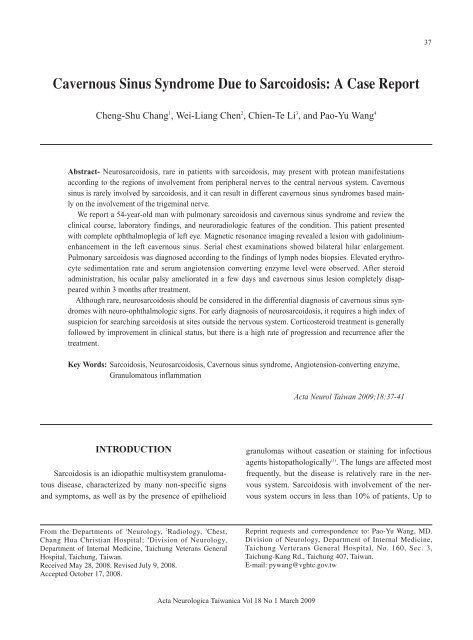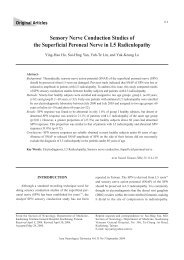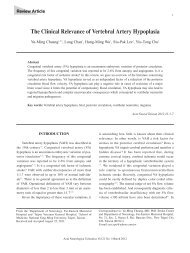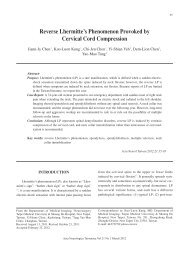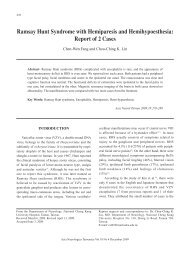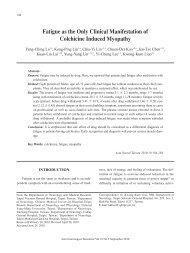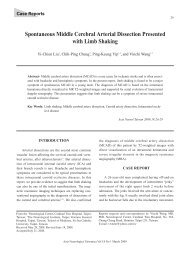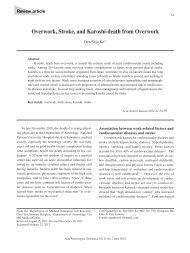Cavernous Sinus Syndrome Due to Sarcoidosis: A ... - Vol.22 No.1
Cavernous Sinus Syndrome Due to Sarcoidosis: A ... - Vol.22 No.1
Cavernous Sinus Syndrome Due to Sarcoidosis: A ... - Vol.22 No.1
Create successful ePaper yourself
Turn your PDF publications into a flip-book with our unique Google optimized e-Paper software.
37<br />
<strong>Cavernous</strong> <strong>Sinus</strong> <strong>Syndrome</strong> <strong>Due</strong> <strong>to</strong> <strong>Sarcoidosis</strong>: A Case Report<br />
Cheng-Shu Chang 1 , Wei-Liang Chen 2 , Chien-Te Li 3 , and Pao-Yu Wang 4<br />
Abstract- Neurosarcoidosis, rare in patients with sarcoidosis, may present with protean manifestations<br />
according <strong>to</strong> the regions of involvement from peripheral nerves <strong>to</strong> the central nervous system. <strong>Cavernous</strong><br />
sinus is rarely involved by sarcoidosis, and it can result in different cavernous sinus syndromes based mainly<br />
on the involvement of the trigeminal nerve.<br />
We report a 54-year-old man with pulmonary sarcoidosis and cavernous sinus syndrome and review the<br />
clinical course, labora<strong>to</strong>ry findings, and neuroradiologic features of the condition. This patient presented<br />
with complete ophthalmoplegia of left eye. Magnetic resonance imaging revealed a lesion with gadoliniumenhancement<br />
in the left cavernous sinus. Serial chest examinations showed bilateral hilar enlargement.<br />
Pulmonary sarcoidosis was diagnosed according <strong>to</strong> the findings of lymph nodes biopsies. Elevated erythrocyte<br />
sedimentation rate and serum angiotension converting enzyme level were observed. After steroid<br />
administration, his ocular palsy ameliorated in a few days and cavernous sinus lesion completely disappeared<br />
within 3 months after treatment.<br />
Although rare, neurosarcoidosis should be considered in the differential diagnosis of cavernous sinus syndromes<br />
with neuro-ophthalmologic signs. For early diagnosis of neurosarcoidosis, it requires a high index of<br />
suspicion for searching sarcoidosis at sites outside the nervous system. Corticosteroid treatment is generally<br />
followed by improvement in clinical status, but there is a high rate of progression and recurrence after the<br />
treatment.<br />
Key Words: <strong>Sarcoidosis</strong>, Neurosarcoidosis, <strong>Cavernous</strong> sinus syndrome, Angiotension-converting enzyme,<br />
Granuloma<strong>to</strong>us inflammation<br />
Acta Neurol Taiwan 2009;18:37-41<br />
INTRODUCTION<br />
<strong>Sarcoidosis</strong> is an idiopathic multisystem granuloma<strong>to</strong>us<br />
disease, characterized by many non-specific signs<br />
and symp<strong>to</strong>ms, as well as by the presence of epithelioid<br />
granulomas without caseation or staining for infectious<br />
agents his<strong>to</strong>pathologically (1) . The lungs are affected most<br />
frequently, but the disease is relatively rare in the nervous<br />
system. <strong>Sarcoidosis</strong> with involvement of the nervous<br />
system occurs in less than 10% of patients. Up <strong>to</strong><br />
From the Departments of 1 Neurology, 2 Radiology, 3 Chest,<br />
Chang Hua Christian Hospital; 4 Division of Neurology,<br />
Department of Internal Medicine, Taichung Veterans General<br />
Hospital, Taichung, Taiwan.<br />
Received May 28, 2008. Revised July 9, 2008.<br />
Accepted Oc<strong>to</strong>ber 17, 2008.<br />
Reprint requests and correspondence <strong>to</strong>: Pao-Yu Wang, MD.<br />
Division of Neurology, Department of Internal Medicine,<br />
Taichung Verterans General Hospital, No. 160, Sec. 3,<br />
Taichung-Kang Rd., Taichung 407, Taiwan.<br />
E-mail: pywang@vghtc.gov.tw<br />
Acta Neurologica Taiwanica Vol 18 No 1 March 2009
38<br />
50% of patients with neurosarcoidosis manifest with a<br />
neurological disease at the time sarcoidosis is diagnosed.<br />
Seventh cranial nerve palsy and meningeal infiltration<br />
are the most frequent findings (2) . Reports regarding sarcoidosis<br />
in the cavernous sinus are rare (3) .<br />
CASE REPORT<br />
Two months before admission, this 54-year-old man<br />
had blurred vision and dizziness. Visual defects were<br />
noticed at that time. He was diagnosed with a pituitary<br />
tumor over anterior lobe of the pituitary gland by magnetic<br />
resonance imaging (MRI). During this presentation,<br />
the patient experienced double vision, headache,<br />
and pho<strong>to</strong>phobia one month later despite medications at<br />
our neurologic outpatient department. On neurologic<br />
examination, the patient was found <strong>to</strong> have impaired<br />
vision acuity of the left eye (6/20), chemosis of the left<br />
conjunctiva, swelling of the left eyelid, prop<strong>to</strong>sis of the<br />
left eye, and complete palsy of the oculomo<strong>to</strong>r, trochlear,<br />
and abducens nerves of the left eye. His pupils size was<br />
isocoria. The visual fields were full. There was a slight<br />
reduction of the sensation in the ophthalmic branch of<br />
the left trigeminal nerve. The left corneal response was<br />
impaired, consistent with a left trigeminal nerve abnormality.<br />
There were no facial palsy, no hearing impairment,<br />
no tinnitus, no dysphagia, no uvula deviation, and<br />
no <strong>to</strong>ngue deviation.<br />
The follow-up MRI of the brain with gadolinium<br />
enhancement revealed a lesion with increased density<br />
over the left cavernous sinus region (Fig 1). The chest<br />
roentgenogram (CXR) revealed bilateral enlarged hilum.<br />
The computed <strong>to</strong>mogram of the chest and mediastinum<br />
with contrast enhancement showed marked homogeneous<br />
enlargement of lymph nodes in the mediastinum<br />
and bilateral hilar regions (Fig 2). The gallium-67 scan<br />
of the chest disclosed markedly increased activity in<br />
bilateral hilar regions and the middle mediastinum.<br />
Biopsy of the left lower paratracheal and superior posterior<br />
mediastinum lymph nodes through mediastinoscope<br />
was done and the pathology showed noncaseating granuloma<strong>to</strong>us<br />
inflammation with negative periodic acid-<br />
Schiff (PAS) and acid-fast stain, compatible with sarcoidosis<br />
(Fig 3). Serological studies, including antineutrophil<br />
cy<strong>to</strong>plasmic antibodies, anti-nuclear antibodies,<br />
and endocrine survey, were negative. The cerebrospinal<br />
fluid (CSF) examination showed protein level of 83.87<br />
mg/dl, white blood cells of 28/mm 3 with lymphocyte predominant<br />
(96%), IgG concentration of 14.8 (normal<br />
range: 0.63~3.35) and an IgG index of 1.0 (normal<br />
range: 0.3~0.7). The serum angiotension-converting<br />
enzyme (ACE) level was 37.8 IU/l (normal range: 8.3-<br />
A B C<br />
Figure 1. Gadolinium-enhanced T1-weighted axial (A) and coronal (B) images show an enhanced mass involving the left cavernous<br />
sinus. Gadolinium-enhanced T1-weighted axial image (C) six months later after steroid therapy shows significant shrinkage<br />
of the left cavernous sinus lesion.<br />
Acta Neurologica Taiwanica Vol 18 No 1 March 2009
39<br />
prop<strong>to</strong>sis were improved 5 days later. The steroid dose<br />
was tapered down and shifted <strong>to</strong> oral prednisolone in the<br />
second week. He received prednisolone at the outpatient<br />
department as ordered later. The size of bilateral hilar<br />
lymph nodes decreased, as revealed by the follow-up<br />
CXR two months later. A follow-up MRI of the brain<br />
revealed resolution of the mass over cavernous sinus<br />
region (Fig. 1). The follow-up serum ACE level had<br />
returned <strong>to</strong> the normal range.<br />
DISCUSSION<br />
Figure 2. The posteroanterior view of chest X-ray shows typical<br />
hilar and paratracheal lymphadenopathy and a<br />
pattern of irregular pulmonary parenchymal involvement.<br />
Figure 3. Pathological findings of the biopsied specimen from<br />
the lymph nodes of the mediastinum shows noncaseating<br />
granuloma<strong>to</strong>us inflammation () with negative<br />
periodic acid-Schiff (PAS) and acid-fast stain.<br />
(H&E staining).<br />
21.4 IU/l).<br />
Intravenous methylprednisolone, 60 mg daily, was<br />
administrated for one week. The patient’s diplopia and<br />
In addition <strong>to</strong> ocular palsy, Jefferson classified three<br />
cavernous sinus syndromes based on the divisions of<br />
trigeminal nerve involvement. The anterior syndrome<br />
comprised deficits of the first division of the trigeminal<br />
nerve, and all the nerves supplying mobility of eyeball.<br />
The middle syndrome included the first and second divisions<br />
of the trigeminal nerve, with denervation of varying<br />
ocular muscles. The posterior syndrome involved the<br />
oculomo<strong>to</strong>r and abducens nerves and the entire trigeminal<br />
nerve, including its mo<strong>to</strong>r component (4) . <strong>Cavernous</strong><br />
sinus syndrome is characterized by ophthalmoplegia,<br />
chemosis, prop<strong>to</strong>sis, Horner syndrome, or trigeminal<br />
sensory loss. The causes of cavernous sinus syndrome<br />
include tumors, infective masses, trauma, thrombosis,<br />
carotid aneurysms and fistulas, and inflamma<strong>to</strong>ry masses.<br />
The diagnosis of neurosarcoidosis is often difficult,<br />
especially in patients without any systemic manifestation.<br />
Definite diagnosis of neurosarcoidosis is confirmed<br />
by noncaseating granuloma pathology, and the absence<br />
of organisms or other causes. The criteria for clinical<br />
diagnosis of neurosarcoidosis has not been well established<br />
in the absence of positive nervous system his<strong>to</strong>logy.<br />
Zajicek et al. proposed diagnostic criteria for three<br />
categories of neurosarcoidosis: certain neurosarcoidosis;<br />
probable neurosarcoidosis; and possible neurosarcoidosis.<br />
A diagnosis of probable neurosarcoidosis can be supported<br />
by clinical or imaging evidence of lesions, with<br />
proof of systemic sarcoidosis obtained from a biopsy of<br />
another organ. In the absence of his<strong>to</strong>logic evidence of<br />
systemic disease, the diagnosis can be based on two or<br />
Acta Neurologica Taiwanica Vol 18 No 1 March 2009
40<br />
more findings, such as typical chest radiograph, gallium<br />
scan findings or elevated serum ACE levels (5) .<br />
<strong>Sarcoidosis</strong> is considered rare in Taiwan since there<br />
has been no island-wide survey. The true annual incidence<br />
of sarcoidosis in Taiwan remains unknown (6) , but it<br />
has increased in the past 3 decades. Although same specific<br />
HLA locus -- HLA-CW7 was found in patients with<br />
sarcoidosis in Taiwan compared with that in England and<br />
Poland, the clinical presentations of patients differed<br />
from those reported from the Western countries (7,8) .<br />
Neurosarcoidosis affects Africans more commonly<br />
but is rare among Chinese. The involvement of the nervous<br />
system in sarcoidosis ranges from 1% <strong>to</strong> 27% of<br />
cases. Strictly neurologic forms generally occurs in 5%<br />
of cases (9) . The prevalence is underestimated due <strong>to</strong> the<br />
silent manifestation of this disease and unavailability of<br />
tissue proof because of the involved location.<br />
Neurosarcoidosis may manifest itself in an acute<br />
fashion or as a slow progressive disease, and varies from<br />
different location involvement from the peripheral nervous<br />
system (PNS) <strong>to</strong> the central nervous system (CNS).<br />
It usually develops within 2 years after the onset of systemic<br />
sarcoidosis. In some patients, neurologic symp<strong>to</strong>ms<br />
may be the first presenting manifestation.<br />
Approximately 80% of neurosarcoidosis patients have<br />
presentations outside the nervous system. Most patients<br />
presenting with neurologic symp<strong>to</strong>ms and signs also<br />
have evidence of pulmonary involvement (10) . Cranial<br />
nerve palsies, especially the facial nerve, are the most<br />
common presentation of neurosarcoidosis, followed by<br />
the optic nerve. Dysphagia and dysphonia could be the<br />
sequela as the glossopharyngeal and vagus nerves are<br />
involved. Uncommon features, hydrocephalus and aseptic<br />
meningitis, are the results of meningeal<br />
involvement (2) . Cerebral parenchyma may be infiltrated<br />
with a wide range of symp<strong>to</strong>ms, including seizures, cognitive<br />
impairment, and personality changes (11) .<br />
Abnormalities in the visual pathways are common in<br />
patients with systemic sarcoidosis, with perineural or<br />
perichiasmal infiltrates. Optic pathway sarcoidosis may<br />
present headache and blurred vision (12) . Myelopathy with<br />
limbs paresis is the result of spinal cord invasion (13) .<br />
It is important <strong>to</strong> exclude other causes, such as neoplasm<br />
or infection, in systemic sarcoidosis patients with<br />
clinical signs of neurological involvement. MRI, the<br />
most sensitive imaging study for neurosarcoidosis, provides<br />
a reasonable level of sensitivity (up <strong>to</strong> 82%), but<br />
relatively poor specificity (14) .<br />
Angiotensin-converting enzyme (ACE), produced by<br />
the epithelioid cells at the peripheral of granuloma<strong>to</strong>us<br />
lesions in response <strong>to</strong> an ACE-inducing fac<strong>to</strong>r released<br />
by T-lymphocytes, can be elevated in some disorders,<br />
including diabetes, silicosis, and cirrhosis (15) . Serum ACE<br />
has been reported as elevated in 5-50% of patients with<br />
neurosarcoidosis, and is clinically useful information in<br />
investigations. It might be a marker of pulmonary<br />
involvement that is also useful in moni<strong>to</strong>ring disease<br />
activity (16) . Furthermore, ACE in the CSF may be elevated<br />
in 50% of patients with CNS sarcoidosis, although<br />
such abnormalities are also found in infection and malignancy<br />
status. A normal level of ACE in the CSF results<br />
can not exclude the diagnosis of neurosarcoidosis.<br />
Owing <strong>to</strong> a lack of specificity, Dale and O’Brien recommended<br />
that it should not be routinely used for investigation<br />
(17) . Abnormal CSF examination may be found in up<br />
<strong>to</strong> 80% neurosarcoidosis patients, such as increased <strong>to</strong>tal<br />
protein, mononuclear pleiocy<strong>to</strong>sis, and elevated IgG<br />
index with oligoclonal bands (5) .<br />
It is important <strong>to</strong> diagnose neurosarcoidosis early in<br />
the course of the disease process, since early treatment<br />
can decrease the damage caused by fibrosis and<br />
ischemia of the affected tissues. Most authorities recommend<br />
initiating corticosteroid therapy as the first-line<br />
therapy <strong>to</strong> alleviate acute symp<strong>to</strong>ms and avoid irreversible<br />
damage <strong>to</strong> the nervous tissues (18) . Corticosteroid<br />
treatment for CNS parenchymal disease and other severe<br />
neurologic manifestations of sarcoidosis usually starts<br />
with prednisolone 1.0 mg/kg/day. These patients often<br />
require prolonged therapy and prednisolone should be<br />
tapered very slowly. One third of patients are found <strong>to</strong> be<br />
refrac<strong>to</strong>ry <strong>to</strong> corticosteroid therapy and require adjunctive<br />
therapy. Potential agents include azathioprine,<br />
methotrexate, cyclophosphamide, hydroxychloroquine,<br />
pen<strong>to</strong>xyfillin, thalidomide, and infliximab (19) . Surgery for<br />
neurosarcoidosis is indicated for diagnosis and therapy,<br />
the latter may ameliorate hydrocephalus or life-threaten-<br />
Acta Neurologica Taiwanica Vol 18 No 1 March 2009
41<br />
ing mass lesions causing increased intracranial pressure<br />
(20) .<br />
Long-term clinical outcome of neurosarcoidosis has<br />
rarely been evaluated. According <strong>to</strong> the report by Ferriby<br />
et al. report, CNS involvement at onset is associated with<br />
a less favorable disease course with increased morbidity,<br />
compared with the involvement of the PNS. The clinical<br />
course is more closely related <strong>to</strong> initial localization than<br />
<strong>to</strong> related <strong>to</strong> the clinical mode. The systemic involvement<br />
is not a predictive fac<strong>to</strong>r for the evolution of neurosarcoidosis<br />
(21) .<br />
There is a high rate of progression and recurrence<br />
after treatment, therefore follow-up imaging is necessary.<br />
An early diagnosis of neurosarcoidosis requires a high<br />
index of suspicion searching for sarcoidosis at sites outside<br />
the nervous system.<br />
REFERENCES<br />
1. Dantzker DR, Tobin MJ, Whatley RE. Respira<strong>to</strong>ry diseases.<br />
In: Andreoli TE, Carpenter CCJ, Plum F, Smith LH,<br />
eds. Cecil Essentials of Medicine. Philadelphia: Saunders,<br />
1986:149.<br />
2. Stern BJ. Neurological complications of sarcoidosis. Curr<br />
Opin Neurol 2004;17:311-6.<br />
3. Zarei M, Anderson JR, Higgins JN, et al. <strong>Cavernous</strong> sinus<br />
syndrome as the only manifestation of sarcoidosis. J<br />
Postgrad Med 2002;48:119-21.<br />
4. Jefferson G. On the saccular aneurysms of the internal<br />
carotid artery in the cavernous sinus. Br J Surg 1938;26:<br />
267-302.<br />
5. Zajicek JP, Scolding NJ, Foster O, et al. Central nervous<br />
system sarcoidosis: diagnosis and management. QJM 1999;<br />
92:103-17.<br />
6. Lee JY, Chao SC, Yang MH, et al. <strong>Sarcoidosis</strong> in Taiwan:<br />
clinical characteristics and atypical mycobacteria. J Formos<br />
Med Assoc 2002;101:749-55.<br />
7. Perng RP, Chou KT, Chu H, et al. Familial sarcoidosis in<br />
Taiwan. J Formos Med Assoc 2007;106:499-503.<br />
8. Perng RP, Chen JH, Tsai TT, et al. <strong>Sarcoidosis</strong> among<br />
Chinese in Taiwan. J Formos Med Assoc 1997;96:697-9.<br />
9. Yamaguchi M, Hosoda Y, Sasaki R, et al. Epidemiological<br />
study on sarcoidosis in Japan. Recent trends in incidence<br />
and prevalence rates and changes in epidemiological features.<br />
<strong>Sarcoidosis</strong> 1989;6:138-46.<br />
10. Nowak DA, Widenka DC. Neurosarcoidosis: a review of its<br />
intracranial manifestation. J Neurol 2001;248:363-72.<br />
11. Delaney P. Seizures in sarcoidosis: a poor prognosis. Ann<br />
Neurol 1980;7:494.<br />
12. Leu NH, Chen CY, Wu CS, et al. Primary chiasmal sarcoid<br />
granuloma: MRI. Neuroradiology 1999;41:440-2.<br />
13. Wang PY. Spinal cord sarcoidosis presenting as an<br />
intramedullary mass: a case report. Zhonghua Yi Xue Za<br />
Zhi (Taipei) 1999;62:250-4.<br />
14. Mafee MF, Dorodi S, Pai E. <strong>Sarcoidosis</strong> of the eye, orbit<br />
and central nervous system. Role of MR imaging. Radiol<br />
Clin North Am 1999;37:73-87.<br />
15. Maliarik MJ, Rybicki BA, Malvitz E, et al. Angiotensinconverting<br />
enzyme gene polymorphism and risk of sarcoidosis.<br />
Am J Respir Crit Care Med 1998;158:1566-70.<br />
16. Hsieh CW, Chen DY, Lan JL. Late-onset and rare faradvanced<br />
pulmonary involvement in patients with sarcoidosis<br />
in Taiwan. J Formos Med Assoc 2006;105:269-76.<br />
17. Dale JC, O’Brien JF. Determination of angiotensin-converting<br />
enzyme levels in cerebrospinal fluid is not a useful test<br />
for the diagnosis of neurosarcoidosis. Mayo Clin Proc<br />
1999;74:535.<br />
18. Johns CJ, Michele TM. The clinical management of sarcoidosis.<br />
A 50-year experience at the Johns Hopkins<br />
Hospital. Medicine (Baltimore) 1999;78:65-111.<br />
19. Vinas FC, Rengachary S. Diagnosis and management of<br />
neurosarcoidosis. J Clin Neurosci 2001;8:505-13.<br />
20. Hamada H, Hayashi N, Kurimo<strong>to</strong> M, et al. Isolated third<br />
and fourth ventricles associated with neurosarcoidosis successfully<br />
treated by neuroendoscopy: case report. Neurol<br />
Med Chir (Tokyo) 2004;44:435-7.<br />
21. Ferriby D, de Seze J, S<strong>to</strong>jkovic T, et al. Long-term followup<br />
of neurosarcoidosis. Neurology 2001;57:927-9.<br />
Acta Neurologica Taiwanica Vol 18 No 1 March 2009


